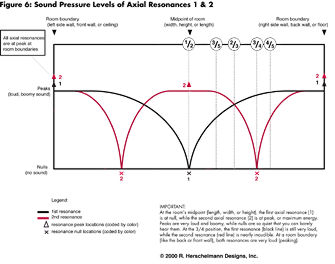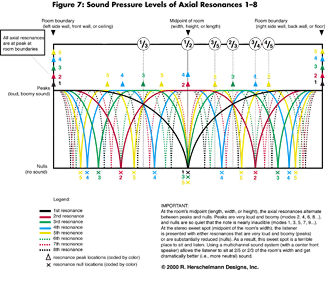Design the Ultimate Home Theater- On a Budget Page 3
To achieve the best sound, concentrate on the speaker and listening positions. Audiophiles often feel that the best seat in the house is the one halfway between the front left and right speakers. This centers the listener between the room's side walls. Being halfway between the left and right speakers provides the best stereo imaging, the impression that musical events are happening at some point between the two speakers. However, both acoustic theory and real-world measurements indicate that the room's midpoint may have numerous low-frequency-response problems.

Room resonances, as I've discussed elsewhere, create peaks (areas of excess sound pressure) and nulls (areas of little pressure). You can calculate these peaks and nulls with little more than a single speaker, a test disc, a calculator, and an SPL meter. First, calculate the first resonant frequency (565 divided by the length, width, or height, in feet). Assuming that you have a full-range loudspeaker or subwoofer, place the speaker in the corner so that you can emphasize all of the room modes. Next, play the resonant or an adjacent frequency off of the test disc. (Stereophile sells a number of test discs with variable low-frequency sine waves. You can also get a variable signal generator from Goldline for about $150.) Your room's construction may shift the resonant frequency slightly, but it should be near the point you've calculated. Finally, walk around the room with the SPL meter and notice how that particular frequency gets louder and softer as you move from one spot to another.
The first resonance peaks for any given room dimensions occur at room boundaries. For a 14-foot-wide room, a 40.3-Hz peak occurs at the each side wall. The null for this frequency occurs halfway between the two walls. If you sit dead-center, you'll probably hear a dip in the frequency response at about 40.3 Hz. This spot will also have a peak at the resonant frequency's second harmonic, 80.6 Hz. The second harmonic will also have nulls about a quarter of the way from the walls (see figure 6). The center spot will have another dip at 120.9 Hz, the third resonance (which has nulls one-third the distance from the walls) and a peak at 161.2 Hz, and so on.
Now, move your speaker along the front wall to the first resonance's null, which is the middle of the room's width. When you energize the room with the resonant frequency of the width (in our case, 40.3 Hz) from the null of that frequency (the middle of the room's width), the response should be less boomy. Unfortunately, the speaker's also playing at the peak of the second harmonic, which means that, when you play 80.6 Hz, the response will be even louder. In some cases, adjusting the crossover point between your subwoofer and your main speakers might allow you to single out the first resonance. In general, though, placing the speakers becomes a balancing act between one resonance and another.

The best speaker/listening position is a place where there are few, if any, peaks or nulls. For a dedicated home theater, you may choose not to have a center seat at all. After all, the center speaker (which, as Russ Herschelmann points out, is best placed slightly off-center) anchors the sounds that correspond with the center of the screen anyway, which allows off-center listeners to hear a good soundstage. See Russ' chart (figure 7). This maps out the peaks and nulls for the first several resonances of a given dimension. As you can see, positions at thirds or fifths of the room's dimensions provide the fewest peaks and dips and seem to offer an equal amount of sound pressure for the majority of resonances. This is certainly a good place to start. However, when placing the listener at either the one-third or two-thirds width position, there's still a peak for the width's third resonance. In our case, this would be at 120 Hz. So, we would place the loudspeakers at the null for this resonance, which would be at a position about one-sixth of the room's width away from the wall.
In those cases where changing the room dimensions is not an option, you might be able to position the loudspeakers and the listener in a way that alleviates the problem. Keeping track of all of these fractions and resonant numbers may be confusing, but the bottom line is simple: No matter what shape your listening room is, in many cases, just changing the speaker or listening position can make a huge difference.
 Tip #4: Build a Wall, Maybe a Floor, but Hopefully Not a Ceiling
Tip #4: Build a Wall, Maybe a Floor, but Hopefully Not a Ceiling
If you're planning to spend a bunch of money on a home theater system, take a look at your room and its dimensions. Using Stereophile Guide to Home Theater's Excel spreadsheet, input the room dimensions. Are the resonances reasonably well distributed? Are there coincidences below 150 Hz? If there are a number of coincidences or the axial modes aren't well distributed, try changing just one of the dimensions, particularly one that's a multiple of another dimension. If moving one wall will create a better distribution of room modes, look at your floor plan to see how feasible it would be to build a new wall. Adding a raised floor may also improve dimensions and can have other benefits I'll discuss next month. You might find that, for a few hundred dollars (if you do it yourself) or maybe a grand (with a contractor), you can just build a new wall. This might create extra storage space, or it might make another room larger, which may help you convince your spouse to go along with the idea. In our case, our testing facility is located in an industrial building that has an existing drop ceiling. This required us to build a new ceiling, which solved the room-dimension problem, but I wouldn't recommend it to anyone. We had to completely redo the electrical, lighting, and HVAC (heating, ventilation, and air-conditioning) systems, not to mention the fact that we had to do most of the work upside down. That said, I still think that building a new wall is doable for the adventurous do-it-yourselfer. A thousand-dollar wall may make your system sound considerably better than a ten-thousand-dollar preamp, so don't dismiss the idea out of hand.





























































